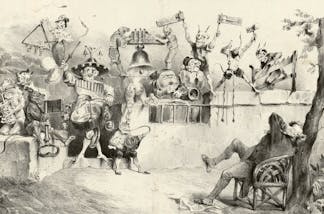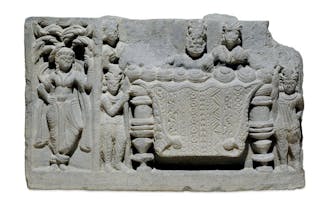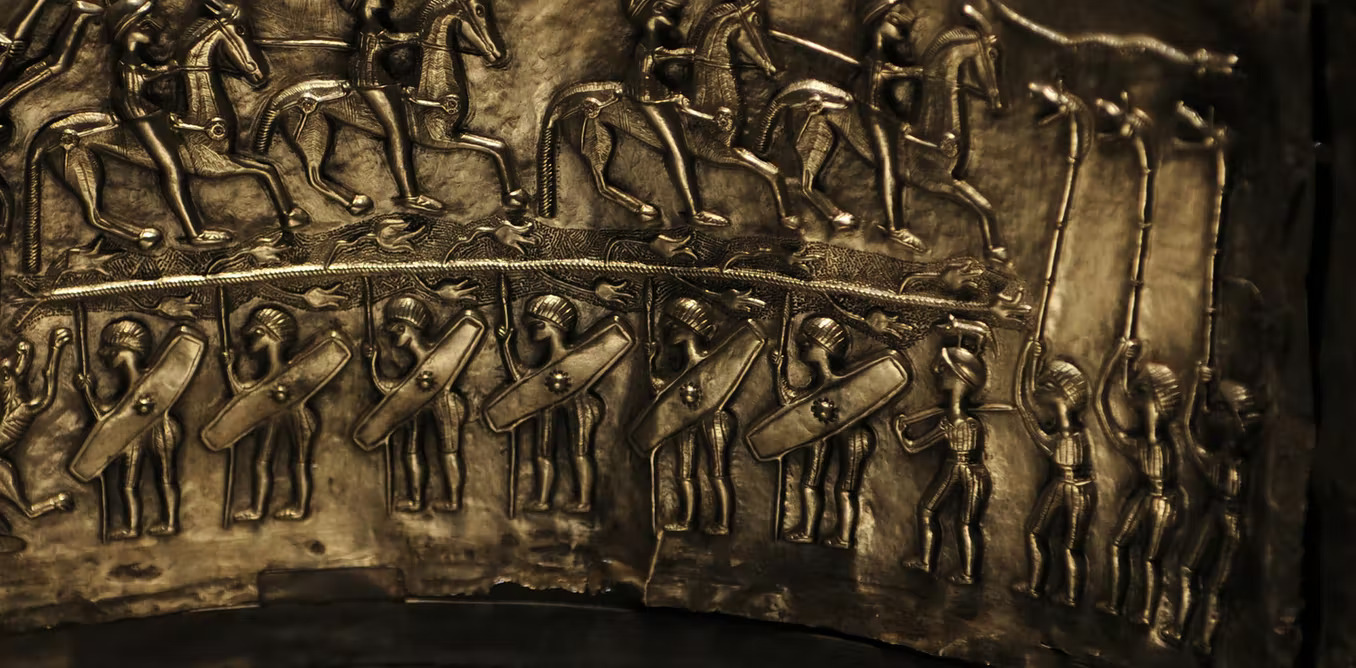
Three soldiers (far right) carry karnyxes, long horns with frightening boar-headed mouths that produce eerie calls during battle. Prisma/Universal Images Group via Getty Images
Calling a jig in the midst of battle
In antiquity, cavalry horses were trained to endure the piercing pipe music that led armies to battle. But a clever reversal of this training could spell victory.
In the seventh century B.C., the Kardians of Thrace, who lived in what is now northwest Turkey, were renowned for their cavalry. For entertainment, the mounted soldiers taught their horses to dance to pipes played at drinking parties. Rearing up and pawing the air, the horses kept time to the lively music.
Captured as a boy from Bisaltia in northeastern Greece, a prisoner named Naris heard about the marvelous dancing horses in the Kardian barbershop where he worked. According to the story recounted by the ancient Greek writer Athenaeus, Naris escaped, returned to Bisaltia, and prepared to make war on Kardia.
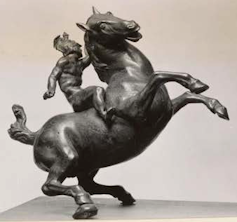
–
He had a secret weapon: a piper girl who had also escaped from Kardia. She taught the Bisaltian soldiers songs from Kardian banquets. Naris led his army out against the Kardian cavalry and signaled for his pipers to play. Pricking up their ears at the familiar tunes, the Kardian horses reared up to dance, throwing off their riders. In the chaos, the Bisaltians crushed the Kardians.
When squeals terrorize living tanks
Cavalrymen of classical antiquity accustomed their horses to the clash of bronze weapons. But in the fourth century B.C., when Alexander the Great’s successors brought war elephants from India, the animals’ trumpeting threw horses into a frenzy.
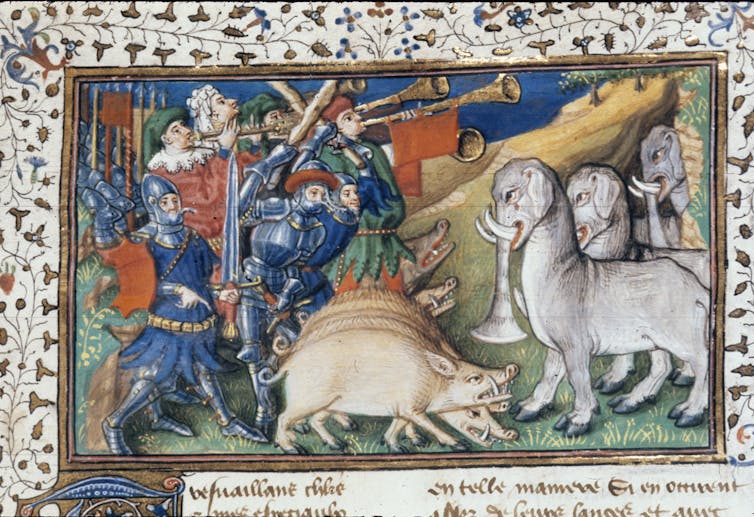
–
Alexander had learned from King Porus during his 326 B.C. Indian campaign that elephants have sensitive hearing and poor eyesight, which makes them averse to unexpected loud, discordant sounds. When Alexander’s scouts reported that elephants were approaching, Porus advised Alexander’s horsemen to grab up pigs and trumpets and ride out to meet them. The shrill sound of the pigs combined with blaring trumpets sent the elephants fleeing.
In 280 B.C., the Romans first encountered war elephants, brought to Italy by Greek King Pyrrhus. The riders in the howdah seats upon their backs created an ear-splitting commotion with drums and clanging spears, causing the Romans and their horses to panic.
But Romans noticed that Pyrrhus’ elephants were unnerved by high-pitched squeals of swine. Like Alexander, the Romans deployed pigs to deflect Pyrrhus’ pachyderms, which contributed to his heavy losses. Later, in 202 B.C., blasts of Roman war trumpets panicked Carthaginian general Hannibal’s war elephants in the Battle of Zama, ending the Second Punic War.
Some commanders tried to obtain an elephant or two to condition their horses in advance of battle. Perseus of Macedon prepared for a Roman attack with war elephants in 168 B.C. by having artisans build wooden models of elephants on wheels. Pipers hidden inside the huge mock-ups played harsh sounds, acclimating the Macedonian horses to the sight and sound of elephants. But Perseus’ preparations were for naught. Even though the mountainous terrain at the Battle of Pydna got the better of the Romans’ 20 elephants, Rome was victorious.
War cries and wailing weapons
Bloodcurdling war cries are a universal way of striking terror in foes. Maori war chants, the Japanese battle cry “Banzai!” (Long Live the Emperor) in World War II, the Ottomans’ “Vur Ha!” (Strike), the Spanish “Desperta Ferro!” (Awaken the Iron), and the “Rebel Yell” of Confederate soldiers are examples. In antiquity, the sound of Greek warriors bellowing “Alala!” while banging swords on bronze shields was likened to hooting owls or a screeching flock of monstrous birds.
The Roman historian Tacitus described the hair-raising effects of the barritus, the war cry of Germanic tribes. The Germans devised a simple technique for intensifying the barritus, which began as a low murmur. The chanting became a roar, then rose to a reverberating crescendo as the men held up their shields in front of their mouths to amplify the thunderous sound.
–
Another technological invention was the karnyx, the Celtic war trumpet. Romans were awed by the eerie, spine-tingling sounds made by the long bronze tube with a wide bell shaped like the gaping jaws of a fierce dragon, boar or wolf. The horn’s loud, lugubrious tones “suited the tumult of war,” wrote Diodorus Siculus around 50 B.C. Later Roman troops used the karnyx themselves.
Another early military sound technology was an arrow that created a fearsome noise. “Whistling” or “screaming” arrows (shaojian) made by the horseback archers of the steppes were described by the Chinese chronicler Sima Qian in about 100 B.C. A small, perforated bone or wood sound chamber – the whistle – was attached to the shaft behind the arrowhead. In battle, the shrieking sound of thousands of whistling arrows terrified enemies and their horses. Screaming arrows have been recovered from archaeological sites in central Asia.
Numerous other technologies to produce booming detonations to disorient and frighten enemies were described in ancient Chinese war manuals. These explosive devices employed gunpowder, invented in China around A.D. 850, reaching Europe about 1250.
Sound weapons in the modern era
Music was used during World War II to cause stress and anxiety: The Soviet army played Argentine tangos through loudspeakers all night to keep German soldiers awake. U.S. loudspeaker teams blasted deafening rock music (including The Doors, Alice Cooper and The Clash) day and night during the U.S. siege of Panamanian Gen. Manuel Noriega in 1989. In the 2000s, Americans again deployed aggravating, incessant music in Iraq and Afghanistan.
Sound weapons have their uses off the battlefield, too. Shopping centers have borrowed the idea, broadcasting classical symphonies and frequencies registered only by teenage ears to keep young loiterers away. In 2022, Australian police bombarded anti-COVID-19 vaccine protesters with recordings of Barry Manilow songs on repeat to break up the crowd.
Recent development of weaponized sound energy is more ominous, often intended for civilian crowd control. Military scientists in the United States, Israel, China and Russia have unveiled “nonlethal” high-decibel and pulsating high- and low-frequency armaments designed to assault the senses. Examples include hand-held or tank-mounted magnetic acoustic devices, sonic-vibration cannons, and long-range acoustic devices, first used by U.S. forces in Iraq in 2004 and later by police against citizen protests in New York and Missouri.
Since 2016, American diplomats in Cuba, Russia, China and elsewhere have experienced “Havana Syndrome,” associated with mysterious neurological and brain injuries thought to be inflicted by unknown high-powered microwave or targeted sonic energy systems. Sound wave transmitters are not only psychologically toxic but can cause pain and dizziness, burns, irreversible damage to inner ears and possibly neurological and internal injuries.
Since antiquity, human creativity in weaponizing devastating noise to confuse and overwhelm adversaries has progressed from intimidation to the infliction of physical injury.
–
- Ancient Greece
- War
- Weapons
- Elephants
- Noise
- Warfare
- Horses
- History of science
- Pigs
- Ancient Rome
- Alexander the Great
- Classical antiquity
- Hannibal
- Sonic weapon
- Havana syndrome
Author Disclosure Statement
Adrienne Mayor does not work for, consult, own shares in or receive funding from any company or organization that would benefit from this article, and has disclosed no relevant affiliations beyond her academic appointment.
Partners
Republish our articles for free, online or in print, under a Creative Commons license.
We need your help
The Conversation is a nonprofit organization working for the public good through fact- and research-based journalism. Nearly half of our budget comes from the support of universities, and higher education budgets are under unprecedented strain. Your gift can help us keep doing our important work and reach more people. Thank you.
Beth Daley 
Editor and General Manager
–
Want to write?
Write an article and join a growing community of more than 150,200 academics and researchers from 4,445 institutions.









